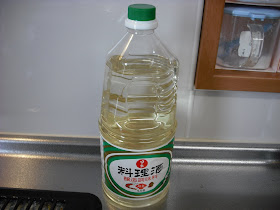Yesterday, I found packs of kanpachi (or kampachi) "ara" (trimmings) sold for 380 yen each at the supermarket I frequent, and I just had to buy one. I first thought that I would simply sprinkle with salt and grill, because I like grilled kanpachi kama so much, but then I changed my mind. I thought it might be a good idea to make kanpachi daikon the way I like it. As usual, I searched for recipes that sounded good, and I decided to use the water, soy sauce, and mirin ratio of 8:1:1 this time.
I'm not sure how to call kanpachi (or kampachi) in English. Wikipedia lists four:
amberjack
Purplish amberjack
Greater yellowtail
Ruderfish
Anyway, buri, kanpachi, and hiramasa are very similar to one another in appearance and flavor.
Kanpachi Daikon
Ingredients:
1 pack kanpachi ara
1/2 daikon
1 knob ginger, sliced
(I acutally used 2, because I like ginger.)
800 ml water
(First I put 800 ml water, but added another 100 ml later to cover the ara.)
100 ml sake
100 ml mirin
100 ml soy sauce
日本では、ぶり大根(ブリ大根)は冬にとても人気のある料理です。私自身は、店で出すようなぶり大根は甘じょっぱ過ぎて、好きではありません。
昨日、よく行くスーパーでカンパチのアラが1パック380円で売っていて、私は思わず買ってしまいました。最初はただ塩焼きにしようと思ったのですが(カンパチのカマの塩焼きが好きなので)、考えを変えて、カンパチ大根を自分なりに作るのも悪くないなあと思いました。いつもの通り、良さそうなレシピーを探し、今回は水、醤油、味醂の割合を8:1:1にすることにしました。
カンパチを英語で何と言うかよく分かりません。Wikipediaでは4つ挙げています。
amberjack
Purplish amberjack
Greater yellowtail
Ruderfish
ともかく、ブリ、カンパチ、ヒラマサは姿、味ともよく似ています。
カンパチ大根
材料
カンパチのアラ1パック
大根1/2
ショウガ ひとかけ
(ショウガは好きなので、実際は、ふたかけ使いました。)
水800 ml
(最初に水を800 ml入れましたが、後でアラがかぶるようもう100 ml足しました。)
日本酒100 ml
味醂100 ml
醤油100 ml soy sauce

Directions:
1. Peel daikon and cut into 2-cm rounds.
I used a peeler.
作り方:
1. 大根は皮をむいて、2 cmの輪切りにします。
私はピーラーを使いました。

If you want to be authentic, peel thickly, using an usuba or nakiri, to remove the hard outer skin, cut in thick (about 3-cm)slices, and chamfer the edges on both sides of each slice.
ちゃんとやりたければ、薄刃や菜切りを使って、皮を厚くむき、厚い(3 cmくらい)輪切りにして、それぞれの輪切りの両面の角を面取りします。

2. Cut kanpachi ara in large pieces, using a deba.
2. カンパチのアラを出刃を使って大きく切り分けます。

3. Boil some water in a pot, put the ara in it, and remove immediately.
3. 鍋でお湯を沸かせ、アラを入れ、すぐに取り出します。

4. Remove blood.
4. 血合いをとります。

5. First put daikon in a pot and then ara. Add sake and water to cover and ginger slices. Bring to a boil.
5. まずは鍋に大根を、次にアラを入れます。日本酒と水をかぶるだけ入れ、ショウガも入れます。沸騰させます。

6. Add mirin, and put a drop lid (otoshi buta). If you don't have one, substitute a sheet of aluminum foil or paper towel.
6. 味醂を入れ、落し蓋を乗せます。持っていなければ、アルミホイルやキッチンペーパーを使います。

7. Put on the lid and simmer for 5 min. Then, add soy sauce. Simmer for another 15 min.
7. 蓋をして、5分煮ます。醤油を入れます。さらに15分煮ます。

By the way, I used cooking sake, not drinking sake.
ところで、私は飲用の酒ではなく料理酒を使いました。

Note that cooking sake usually contains some salt to avoid liquor tax. Mine contains 2.1% salt.
料理酒には通常、酒税を逃れるため塩分が少し入っています。私のには2.1%入っています。

Almost done!
Note that the paper towel remained intact.
もうそろそろ!
キッチンペーパーは元のままです。

Drop lid removed:
落し蓋を取ったところ:

Looks delicious! (Gross?)
美味しそう!(気持ち悪い?)

Top with yuzu zest, if you can.
できれば柚子の皮を乗せて下さい。

Edited to add: I forgot to mention that I also made a cross cut on both sides of each daikon slice so that it could be seasoned more quickly.
Also, if you want to be authentic, parboil daikon in "kome no togijiru" (milky water resulting from washing uncooked rice) for 5 min. to 1 hour, depending on the recipe, for aku nuki (harshness removal) before simmering with ara.
追記:書くのを忘れていましたが、各大根の両面には十字の切れ込みを入れて、早く味が染み込むにしました。
また、ちゃんとしたいのであれば、大根はアラと煮る前に、あく抜きのため、米の研ぎ汁(お米を研いだ時にできる乳白色の水)で、レシピーにより5分から1時間、茹でて下さい。
As you may have already noticed, the final water + sake, soy sauce, and mirin ratio was 10:1:1 (900 ml water + 100 ml sake, 100 ml soy sauce, and 100 ml mirin), not 8:1:1.
すでに気付いているかも知れませんが、最終的な水+酒、醤油、みりんの割合は8:1:1ではなく10:1:1(水900 ml + 酒100 ml、醤油100 ml、みりん100 ml)になりました。
Hiroyuki, one of my favorite Japanese restaurants serves buri daikon in the winter, and I just love it, so I'd like to give your recipe a try. How did you like your dish using the 8:1:1 ratio?
ReplyDeleteAmy: The 8:1:1 ratio works fine with many all nimono (simmered dishes), and buri daikon is no exception. If you think it's too light for you, just continue to simmer, with additional soy sauce and mirin/sugar, if necessary, until the daikon turns "ame iro" (light brown), like these:
ReplyDeletehttp://images.google.co.jp/images?hl=ja&source=hp&q=%E3%81%82%E3%82%81%E8%89%B2%E3%80%80%E3%81%B6%E3%82%8A%E5%A4%A7%E6%A0%B9&btnG=%E7%94%BB%E5%83%8F%E6%A4%9C%E7%B4%A2&gbv=2&aq=f&oq=
Good luck, and happy cooking!
For some reason, the URL doen't work for me.
ReplyDeleteTry a google image search with
あめ色 ぶり大根
and you will get ameiro buri daikon images.
Great! Thanks for the tips, Hiroyuki!
ReplyDelete